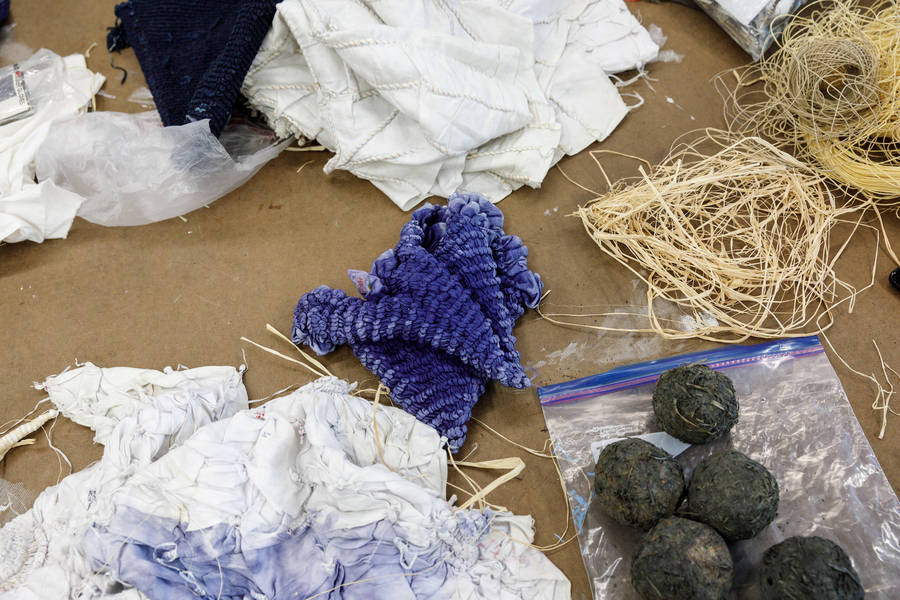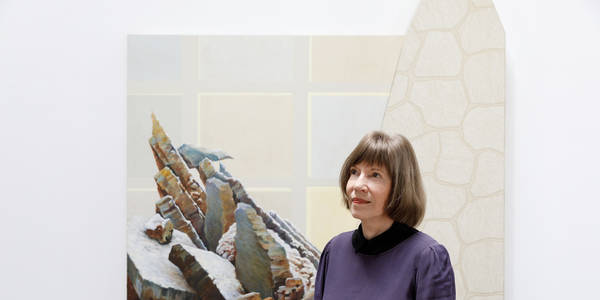
feature / sponsored-projects / art / graphic-design / illustration / interaction-design / product-design
October 11, 2019
Writer: Solvej Schou
Altogether now! Transdisciplinary Studio courses allow students to collaborate across different majors
On a grey cloudy day in a second-floor classroom at the 870 building on ArtCenter’s South Campus, students from a wide range of departments—Illustration, Fine Art, Product Design, Graphic Design and more—sit at long rectangular tables and happily chat while twisting natural fiber yarn around pieces of white cloth.
The students then dunk the cloth-and-yarn creations into vats of plant-based indigo dye, soaking them a deep pigmented blue. After hanging the bundles to dry, they unwrap the yarn—made from the leaves of raffia palm trees—and spread the cloth out, revealing beautiful patterns shaped like moons and stars.
These works were created as part of Indigo, a Spring 2019 Transdisciplinary Studio (TDS) course on the tradition of dying textiles using indigo. Central to a well-rounded ArtCenter education, TDS courses combine upper term students from multiple departments on projects requiring several areas of specialization.

Indigo is co-taught by Fine Art Chair Laura Cooper and, from the Illustration Department, Associate Professor Christine Nasser, Adjunct Assistant Professor Nancy Riegelman and Chair Ann Field, who conceived of the course. On this particular day, guest Gasali Adeyemo—a Nigerian-born dye master based in New Mexico—shows the students dyeing techniques. Guest Christina Kim, the South Korean-born founder of the eco-conscious Los Angeles brand Dosa, talks about sustainable and mindful approaches to dyeing both clothing and textiles.
“Indigo is celestial,” says Kim. “In Yoruba, indigo means ‘love.’” Adeyemo, wearing his own indigo-dyed shirt, adds that “the shape on the fabric is the message and has meaning.” Illustration student Cheyanne Zavala unfolds her mash of yarn and dyed cloth. “I thought that taking this course would be a good way to make portfolio pieces,” she says, smiling. Product Design student Tim Li looks blissful as he sits with other students—and without computers. “This is so much fun,” he says. “Because this is a TDS, we get to be with Fine Art majors. That benefits me in what I do as a designer.”
Communal and flexible collaboration and learning are exactly the purpose of TDS courses.


TDS courses such as Indigo allow students immersed in industrial and commercial design disciplines to work with students from visual art-based majors. Many TDS courses are Sponsored Projects, in which students from more than one department develop business ideas and strategies for corporate sponsors. A number of TDS courses are presented through ArtCenter’s social innovation department Designmatters. Students need to take a TDS course to graduate.
“These courses are always so intriguing because of their diverse project results,” says Provost Karen Hofmann, adding that though the College has offered TDS courses that mix disciplines for nearly two decades, they still deliver the unexpected. “It’s a somewhat experimental approach that continues to push innovative and creative thinking.”
A Sponsored Project model began decades ago, in the ‘60s and ‘70s, with the goal of multiple perspectives and skill sets coming together with industry partners, from car to technology companies, says Hofmann. In the early 2000s, the broader TDS studio model came out of that holistic approach, connecting Humanities and Sciences courses with studio courses. The late Provost Ron Jones, who passed away in 2019, helped coin the term “transdisciplinary” within ArtCenter’s curriculum. In 2001, Jones explained that these courses were designed to help students move between disciplines “with ease from one to the other in natural, instinctive movements.”

“In a TDS, there’s a creative tension in the classroom as students are forced out of their comfort zones and get to experience a collaboration with peers who may have a very specific process of working,” says Hofmann, highlighting that the way in which photographers, graphic designers, illustrators and product designers approach a project can vary greatly. “The atmosphere reflects what is happening today in industry where various disciplines are working together more than ever.”
Examples of TDS courses include Product Design Associate Professor Fridolin Beisert’s ongoing Creative Strategies, Fine Art Assistant Professor Olga Koumoundouros’ Social Engaged Art, and KBA-NotaSys, exploring what banknotes might look like in the future. Faculty also get a chance to collaborate in TDS courses, and Indigo is a good example, says Hofmann.

Field emphasizes that students are taught the same approaches in class, and yet their projects yield dramatically different results. “There’s a joy in learning alongside students from other majors, developing new skills and opening the door to understanding how to work in an experimental way, with a purpose,” she says.
Cooper, eating lunch at the Hillside Campus a few weeks after the Indigo workshop, lights up when discussing TDS courses. She’s co-taught many, including Second Nature, which explored cultural representations of nature and the history of painted landscapes, photography, cinema, design, poetry, literature and more. Indigo allows students to break away from technology.
“TDS courses are close to my heart, because I share the value of thinking about the classroom as an interdisciplinary laboratory,” she says. “Everybody needs more time to use their hands, and make something tangible. With Indigo, we do that with every single class.”

Across campus in the 1111 building, Designmatters TDS Game On: Inspiring a Healthy L.A. for 2028 takes a different and more tech-centric and client-based approach. At the midterm, teams of students pack into a room on South Campus to present their projects to representatives from the Cedars-Sinai Research Center for Health Equity and the City of Los Angeles Department of Recreation and Parks, two of the course’s four industry partners. The other two partners are the science education museum Discovery Cube Los Angeles and the GPS navigation and wearable technology firm Garmin International.
The students are challenged to develop digital ecosystems—including apps and low-tech tools—to engage L.A. residents in a city-wide health initiative designed to boost both physical activity and community participation. Students reached out to L.A. residents across a cultural and socioeconomic spectrum for research. Hosted by the Product Design and Interaction Design departments, Game On is led by Product Design Professor Krystina Castella and Graphic Design Associate Professor Brian Boyl.

“TDS courses level the playing field for students, and they get to shed their major and their expectations of themselves,” says Castella. “They also get to expand their social circle of friends.”
Students Kristy Cheng (Graphic Design), Yanqi Li (Product Design), Shiya Zeng (Interaction Design) and Daniel Kim (BFA 19 Graphic Design) present about an app for low-income L.A. families featuring a wrist band and badges. The app tracks health data, exercise and affordable activities, with community building through alerts about neighborhood events.
Afterwards, Li, who also has both a bachelor’s degree and a master’s degree in mechanical engineering, reflects on why TDS courses are just so valuable.
“This is my first team-based TDS project, and it’s amazing how students from different departments have different mindsets and styles of working,” she says. “It’s about finding the right way to work together with your team. I’ve learned so much from the other students. We’re all really passionate.”


















